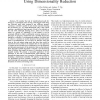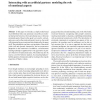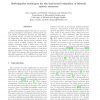725 search results - page 92 / 145 » Learning Behaviors Models for Robot Execution Control |
RSS
2007
13 years 10 months ago
2007
Abstract— We consider the task of omnidirectional path following for a quadruped robot: moving a four-legged robot along any arbitrary path while turning in any arbitrary manner....
BC
2008
13 years 8 months ago
2008
In this paper we introduce a simple model based on probabilistic finite state automata to describe an emotional interaction between a robot and a human user, or between simulated a...
ROBOCUP
2000
Springer
14 years 8 days ago
2000
Springer
Building agents for a scenario such as the RoboCup simulation league requires not only methodologies for implementing high-level complex behavior, but also the careful and efficien...
ICAS
2009
IEEE
14 years 3 months ago
2009
IEEE
Modern distributed systems that have to avoid performance degradation and system overload require several runtime management decisions for load balancing and load sharing, overloa...
ICRA
2010
IEEE
13 years 7 months ago
2010
IEEE
— Allowing robots to communicate naturally with humans is a major goal for social robotics. Most approaches have focused on building high-level probabilistic cognitive models. Ho...



